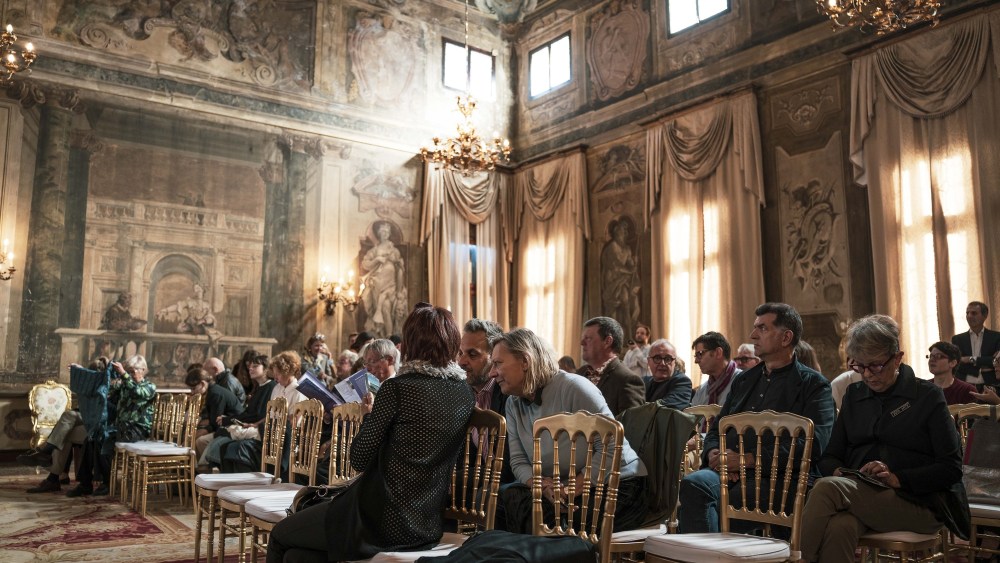VENICE — On a Venetian balcony corniced with ornate Gothic accents overlooking the slow traffic on the Grand Canal, modern jewelry collections sit next to ancient masterpieces at the recently restored Galleria Giorgio Franchetti alla Ca’ d’Oro.
Contemporary jewelry designs by Greece’s Stavroula Pagkrati, Mexico’s Paula Guzman and South Korea’s Seong-ae Kim encourage the design curious to sit a while and ponder how the old codes continue to inspire contemporary creatives.
Ca d’Oro, the “golden house,” was once covered in gold leaves at its pinnacle, and was built by architect Giovanni Bon and his son Bartolomeo for the Contarini family in 1442 and is a bastion of the late Gothic era. It’s just one of the “secret” places Venice Design Week aims to promote on its walking and vaporetto tour for the nine-day design event that ends here Sunday.

The Ca’ d’Oro Museum in Venice.
Marco Valmarana/Courtesy of Dior
Held every October since 2010, the lagoon comes alive with exhibitions, conferences, meetings and workshops that show off the museums, galleries, hotels, and artisan workshops — many of which are closed to the public most of the year — Venice Design Week’s founder and coordinator Lisa Balasso told WWD as she surveyed the setup process in 11th-century Catholic shrine Sala San Leonardo.
In addition to design and jewelry, lighting featured prominently this year with a Light Tour that included the work of Julie Conway, a glassblower and lighting designer based in Seattle; Spanish designer Patricia Urquiola, and Venetian Michele dal Bon. The Interior Design section featured the work of European furniture firm Arkitettoria, Milan-based architectural designer Otto Studio, and Gargallo, Novara, Italy-based Tato, which brought the design of the ’50s and ’60s to the lagoon with a special exhibition with projects by Gio Ponti and Ignazio Gardella.

A visitor poses with the itinerary map of Venice Design Week.
Alberto Pagliuca for Venice Design Week
Balasso said that the event, which has partnered with the Municipality of Venice, continues to grow and saw its number of visitors rise about 30 percent to around 13,000 compared to last year.
Among the secret places on the trail is the island of San Servolo in the Venetian Lagoon, which lies southeast of San Giorgio Maggiore. Once a monastery of Benedictine monks and later a mental hospital, the island is now home to a museum and Venice International University where an exhibit “Horizons From the Island, Another Look at Design” was held.
Back in San Leonardo, Milan-based designer and architect Valeria Molinari unfurled an interactive exhibit “Backgammon Beauty” in the form of a huge carpet, designed into a life-sized, playable game with resin pieces that incorporate aspects of marine life. Backgammon, she notes, originated in ancient Mesopotamia, now modern Iraq. “The significance behind it is to ask people ‘why we forget to play?’”
Molinari, who also unfurled a project with designer Luisa Beccaria called Arcadia Dreams during Milan Design Week in April, said the Venice Design Week allowed her to interact with potential markets like the U.S. in a more intimate setting. “This event is totally different. The public here is open to a moment of discovery,” she said, citing a significant presence of Asian and U.S. visitors.

Valeria Molinari
Alberto Pagliuca for Venice Design Week
The event also drew visitors to the Ca’ di Dio hotel, a project spearheaded by Urquiola, whose intention was to maintain a strong bond with Venice, both in the design of the public spaces and the rooms that refer to the reflections of the water. The palace, which is just steps away from the Venice Biennale location, was initially designed by Italian sculptor and architect Jacopo Sansovino in the 16th century.

Lighting by Julie Conway.
Courtesy of Julie Conway
Inside the hotel, lighting elements once again took center stage, where local artisan companies like Lorenzo Panisson’s LP Glass Murano glassworks were on display: the large chandelier of the lobby, the wall lamps and floor lamps made blown by mouth in the glass factory based on a design by the Urquiola studio.
“People appreciate because they get to discover secret places that otherwise wouldn’t be accessible,” Balasso concluded. “At the same time they get to know artisans who don’t have a showroom and are difficult to get to know on one’s own.”

Tato designs.
Alberto Pagliuca for Venice Design Week

